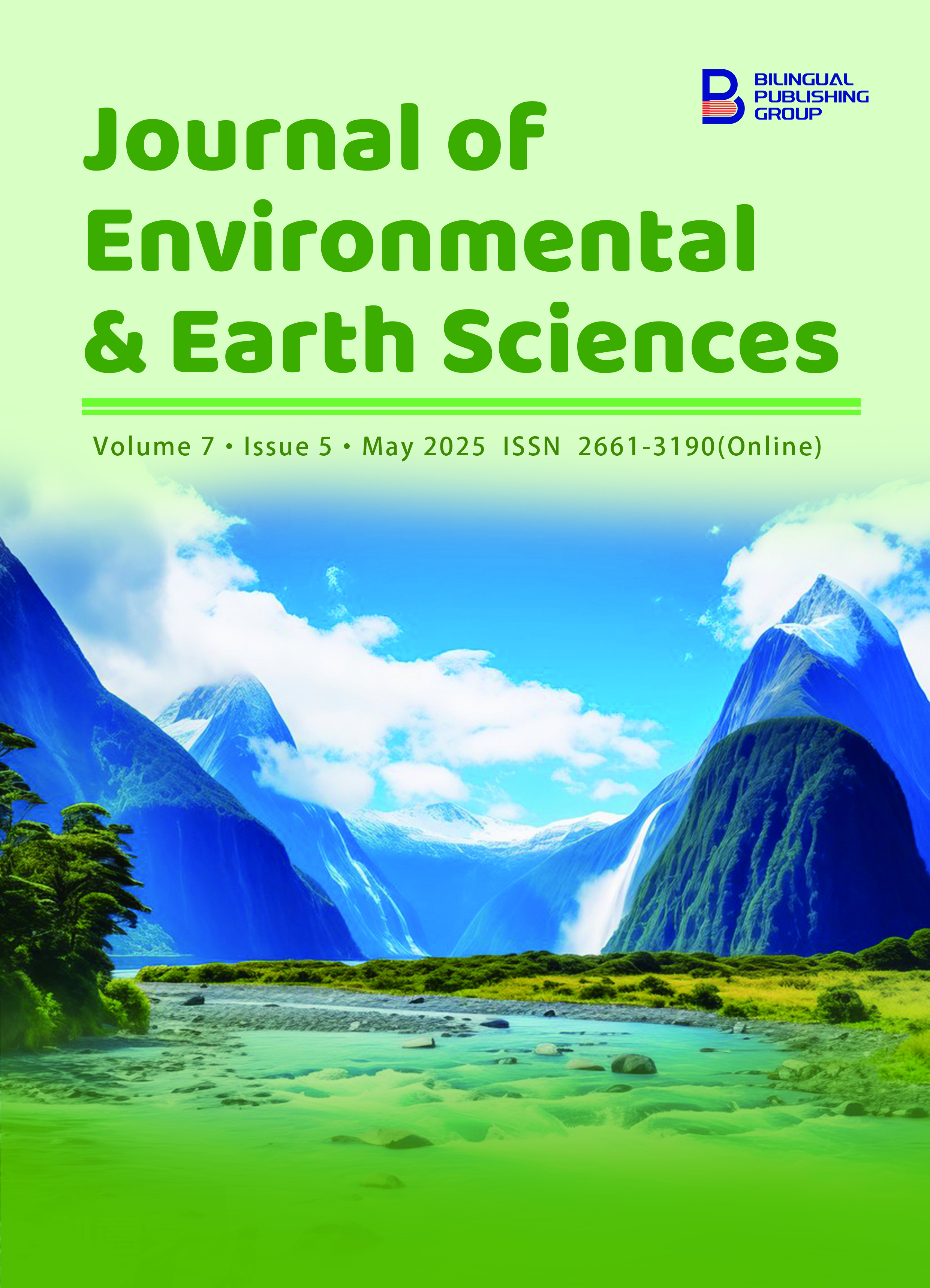
Sub-Watershed Prioritization of Chambal River Basin Using Morphometric and Topo-Hydrological Parameters
DOI:
https://doi.org/10.30564/jees.v7i5.8463Abstract
Natural resource management is essential to sustain human well-being and the environment. Water and soil are two of the most important natural resources that require careful management. The western part of India faces multiple challenges, including climatic variability, soil degradation, water scarcity, deforestation, etc. The basin’s sub-watersheds are delineated and prioritised using the Soil and Water Assessment Tool (SWAT) and Sub Watershed Prioritization Tool (SWPT), respectively, using morphometric and topo-hydrological characteristics, and the sub-watersheds are further ranked using Weighted Sum Analysis (WSA). The findings indicate that SWS19, SWS18, SWS1, SWS17, SWS16, and SWS15, which are drained by the rivers Chambal, Kali Sindh, Mashi, Parbati, Parwan, and Beradi, are highly vulnerable sub-watersheds. By integrating remote sensing, GIS techniques, and quantitative morphometric analysis, parameters such as drainage density, stream frequency, bifurcation ratio, and slope gradient were evaluated. The analysis revealed critical sub-watersheds characterized by steep slopes, high drainage density, and poor vegetation cover, indicating their susceptibility to erosion and runoff. The findings underscore the necessity for targeted soil conservation measures, such as contour bunding, afforestation, and water retention structures. This study highlights the utility of geospatial tools for sustainable watershed management and provides a replicable framework for prioritizing sub-watersheds in similar regions.
Keywords:
Morphometric Analysis; Topo-Hydrology; Sub-Watershed Prioritization Tool (SWPT); Natural Resource Management; Soil and Water; Weighted Sum Analysis (WSA); Chambal River BasinReferences
[1] Rockström, J., Steffen, W., Noone, K., et al., 2009. A safe operating space for humanity. nature, 461(7263), 472–475.
[2] United Nations, 2019. World Population Prospects 2019. Available from: https://www.un.org/development/desa/pd/news/world-population-prospects-2019-0.
[3] Millennium Ecosystem Assessment. 2005. Ecosystems and Human Well-being: Synthesis, Washington, DC, I. PressAvailable from: https://www.millenniumassessment.org/documents/document.356.aspx.pdf.
[4] Barnosky, A.D., Hadly, E.A., Bascompte, J., et al., 2012. Approaching a state shift in Earth’s biosphere. Nature. 486(7401), 52–58.
[5] World Wildlife Fund, 2018. Living Planet Report - 2018: Aiming Higher, Available from: https://www.worldwildlife.org/pages/living-planet-report-2018.
[6] Gleick, P.H., 2003. Global freshwater resources: soft-path solutions for the 21st century. Science. 302(5650), 1524–1528.
[7] Falkenmark, M., Rockström, J., 2004. Balancing water for humans and nature: the new approach in ecohydrology, Earthscan.
[8] Aher, P., Adinarayana, J., Gorantiwar, S., 2014. Quantification of morphometric characterization and prioritization for management planning in semi-arid tropics of India: a remote sensing and GIS approach. Journal of Hydrology. 511, 850–860.
[9] Bhattacharya, B., Mazzoleni, M., Ugay, R., 2019. Flood inundation mapping of the sparsely gauged large-scale Brahmaputra basin using remote sensing products. Remote Sensing. 11(5), 501.
[10] Meyer, W.B., Turner, B.L., 1994. Changes in land use and land cover: a global perspective. Cambridge University Press: Cambridge, UK.
[11] Pimentel, D., Burgess, M., 2013. Soil erosion threatens food production. Agriculture. 3(3), 443–463.
[12] Tejwani, K., Gupta, S.K., Mathur, H.N., 1975. Soil and Water Conservation Research in India, 1956-71.
[13] Srinivasan, V., Lambin, E., Gorelick, S., et al., 2012. The nature and causes of the global water crisis: Syndromes from a meta-analysis of coupled human-water studies. Water Resources Research, 48, 10516.
[14] Arabameri, A., Pradhan, B., Pourghasemi, H.R., et al., 2018. Identification of erosion-prone areas using different multi-criteria decision-making techniques and GIS. Geomatics, Natural Hazards and Risk, 9(1), 1129–1155.
[15] Mishra, P., Tripathi, K., 2013. Soil and water conservation research for land management in India. Indian J. Dryland Agric. Res. Dev, 28(1), 1–18.
[16] Kale, V.S., 2005. Fluvial hydrology and geomorphology of monsoon-dominated Indian rivers. Revista Brasileira de Geomorfologia, 6(1).
[17] Patel, D.P., Gajjar, C.A., Srivastava, P.K., 2013. Prioritization of Malesari mini-watersheds through morphometric analysis: a remote sensing and GIS perspective. Environmental earth sciences, 69(8), 2643–2656.
[18] Singh, P., Gupta, A., Singh, M., 2014. Hydrological inferences from watershed analysis for water resource management using remote sensing and GIS techniques. The Egyptian Journal of Remote Sensing and Space Science. 17(2), 111–121.
[19] Horton, R.E., 1945. Erosional development of streams and their drainage basins; hydrophysical approach to quantitative morphology. Geological society of America bulletin, 56(3), 275–370.
[20] Strahler, A.N., 1964. Quantitative geomorphology of drainage basin and channel networks. Handbook of applied hydrology.
[21] Biswas, S., Sudhakar, S., Desai, V., 1999. Prioritisation of subwatersheds based on morphometric analysis of drainage basin: A remote sensing and GIS approach. Journal of the Indian society of remote sensing, 27, 155–166.
[22] Sinha, R., Bapalu, G., Singh, L., et al., 2008. Flood risk analysis in the Kosi river basin, north Bihar using multi-parametric approach of analytical hierarchy process (AHP). Journal of the Indian Society of Remote Sensing, 36, 335–349.
[23] Meyer, V., Scheuer, S., Haase, D., 2009. A multicriteria approach for flood risk mapping exemplified at the Mulde river, Germany. Natural hazards, 48, 17-39.
[24] Fernández, D., Lutz, M.A., 2010. Urban flood hazard zoning in Tucumán Province, Argentina, using GIS and multicriteria decision analysis. Engineering Geology, 111(1–4), 90–98.
[25] Samal, D.R., Gedam, S.S., Nagarajan, R., 2015. GIS based drainage morphometry and its influence on hydrology in parts of Western Ghats region, Maharashtra, India. Geocarto International, 30(7), 755–778.
[26] Ayele, G.T., Teshale, E.Z., Yu, B., et al., 2017. Streamflow and sediment yield prediction for watershed prioritization in the Upper Blue Nile River Basin, Ethiopia. Water, 9(10), 782.
[27] Meshram, S.G., Sharma, S., 2017. Prioritization of watershed through morphometric parameters: a PCA-based approach. Applied Water Science, 7, 1505–1519.
[28] Central Water Commission. 2014. Integrated hydrological data book (non-classified river basins), New Delhi, India.
[29] INLAND WATERWAYS AUTHORITY OF INDIA. 2017. Final Feasibility Report on Detailed Hydrographic Survey in Chambal River, I.W.A.O. INDIAAvailable from: https://iwai.nic.in/sites/default/files/NW-24%20FINAL%20FR%20CHAMBAL%20RIVER.pdf.
[30] Kumar, R., Kasana, P., Devrani, R., et al., 2024. The Chambal badlands of Ganga River Basin, India: a fading geoheritage odyssey. Geoheritage, 16(4), 93.
[31] Horton, R.E., 1932. Drainage-basin characteristics. Transactions, American geophysical union, 13(1), 350–361.
[32] Schumm, S.A., 1956. Evolution of drainage systems and slopes in badlands at Perth Amboy, New Jersey. Geological society of America bulletin, 67(5), 597–646.
[33] Potter, P.E., 1957. A Quantitative Geomorphic Study of Drainage Basin Characteristics in the Clinch Mountain Area, Virginia and Tennessee. Journal of geology. 65(1), 112–113.
[34] Beven, K.J., Kirkby, M.J., 1979. A physically based, variable contributing area model of basin hydrology/Un modèle à base physique de zone d'appel variable de l'hydrologie du bassin versant. Hydrological sciences journal, 24(1), 43–69.
[35] Whipple, K.X., Tucker, G.E., 1999. Dynamics of the stream‐power river incision model: Implications for height limits of mountain ranges, landscape response timescales, and research needs. Journal of Geophysical Research: Solid Earth, 104(B8), 17661–17674.
[36] Moore, I., Burch, G., 1986. Modelling erosion and deposition: topographic effects. Transactions of the ASAE. 29(6), 1624–1630.
[37] Arnold, J.G., Srinivasan, R., Muttiah, R.S., et al., 1998. Large area hydrologic modeling and assessment part I: model development 1. JAWRA Journal of the American Water Resources Association, 34(1), 73–89.
[38] Rahmati, O., Samadi, M., Shahabi, H., et al., 2019. SWPT: An automated GIS-based tool for prioritization of sub-watersheds based on morphometric and topo-hydrological factors. Geoscience Frontiers, 10(6), 2167–2175.
[39] Abdulkareem, J.H., Pradhan, B., Sulaiman, W.N.A., et al., 2018. Quantification of runoff as influenced by morphometric characteristics in a rural complex catchment. Earth Systems and Environment, 2, 145–162.
[40] Abdulkareem, J.H., Sulaiman, W.N.A., Pradhan, B., et al., 2018. Long-term hydrologic impact assessment of non-point source pollution measured through land use/land cover (LULC) changes in a tropical complex catchment. Earth systems and environment, 2, 67–84.
Downloads
How to Cite
Issue
Article Type
License
Copyright © 2025 Teja Ram Nitharwal, Vipin Chandra Lal, Arun Pratap Mishra, Kaushalendra Kumar Karvendu, Rashmi Singh, Geeta Kumari, Ashvini Kumar

This is an open access article under the Creative Commons Attribution-NonCommercial 4.0 International (CC BY-NC 4.0) License.







 Teja Ram Nitharwal
Teja Ram Nitharwal






